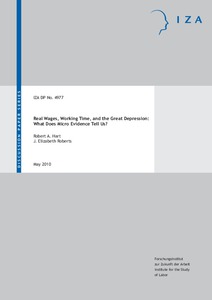Real wages, working time, and the great depression: what does micro evidence tell us?
"Based largely on industry-level aggregate statistics, the prevailing view, and one that has strongly influenced macroeconomic thought, is that real wages during the cycle containing the Great Depression are either acyclical or countercyclical. Does this finding hold-up when more micro data are...
| Main Authors: | , |
|---|---|
| Institution: | ETUI-European Trade Union Institute |
| Format: | TEXT |
| Language: | English |
| Published: |
Bonn
2010
IZA |
| Subjects: | |
| Online Access: | https://www.labourline.org/KENTIKA-19184409124919026819-Real-wages,-working-time,-and-.htm |
| Summary: | "Based largely on industry-level aggregate statistics, the prevailing view, and one that has strongly influenced macroeconomic thought, is that real wages during the cycle containing the Great Depression are either acyclical or countercyclical. Does this finding hold-up when more micro data are employed? We examine this question based on detailed blue-collar workers’ company payroll data for a large section of the British engineering and metal working industries. We distinguish between pieceworkers and timeworkers, with pieceworkers accounting for over half the workforce. For the period 1927 to 1937, the two pay groups are broken down into 14 occupations, and 48 travel-to-work geographical districts. We estimate wage and hours cyclicality in respect of the national unemployment rate as well as the district rates. Weekly hours and real weekly earnings are found to be strongly procyclical. Real hourly earnings of pieceworkers are also significantly procyclical. The roles of standard and overtime hours are crucial to these findings. " |
|---|---|
| Physical Description: | 44 p. Paper Digital |

